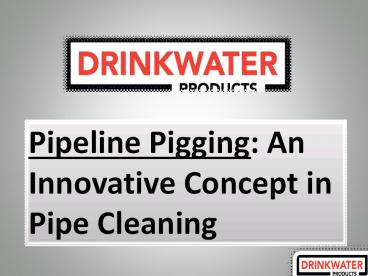Pipeline pigging - PowerPoint PPT Presentation
Title:
Pipeline pigging
Description:
Pipeline Pigging- An Innovative Concept in Pipe Cleaning. Product manufacturers and distributors often use pipelines in the process , and pipeline pigging can ensure that the lines run smoothly. – PowerPoint PPT presentation
Number of Views:2281
Title: Pipeline pigging
1
Pipeline Pigging An Innovative Concept in Pipe
Cleaning
2
Product manufacturers and distributors often use
pipelines in the process , and pipeline pigging
can ensure that the lines run smoothly. Slow
transmission, cracks, flaws and plugging can have
disastrous consequences in a manufacturing plant.
Similarly, plants that produce more than one
liquid product using the same infrastructure, can
suffer contamination unless the pipes are
thoroughly cleaned on the inside before a new
product is inserted.
3
Pipeline pigs are maintenance tools that are
introduced into pipelines by means of a 'pig
trap', which consists of a launcher and receiver.
The pig can be used without causing any flow
disruptions, and it can be forced through either
product flow, or by being towed by a cable or
other device.
4
Why Call it Pipeline Pigging?
After all, a pipeline pig is not an animal...The
one hypothesis is that 'pig' is short for
Pipeline Intervention Gadget and another - more
far-fetched - theory is that a leather pig was
sent through a pipeline when the method was
started, and it made a squeaking sound as it
scraped along the walls of the pipes, much like
an actual farm pig.
5
What is Pipeline Pigging?
The pipeline pig is usually a spherical or
cylindrical device that sweeps the inner walls of
the pipes, scraping the sides as it pushes debris
through towards the exit point. Not only does it
clean the pipes, but it can also be used to
inspect the integrity of the pipe interiors. As
technology continues to evolve, pipeline pigging
has evolved to perform different functions.
6
Utility pigs (solid cast pigs, foam pigs and
mandrel pigs) are used to clean pipeline, much
like you would clean a plumbing line. Over time,
construction debris can start accumulating inside
the pipeline and that's why it is so important
that lines are cleared before production
commences. The utility pig will scrape away
debris. While a sealing pig removes liquids from
the pipe, it can also act as a separator between
different products using the same pipeline.
Inspection pigs (inline inspection pigs) can
gather information about the temperature,
pressure, bends, diameter, curvature, corrosion,
and metal loss from inside the pipes. Using
ultrasonic sounds, a utility pig can measure the
thickness of the pipe wall from the inside.
7
Specialty pigs can isolate a section of the
pipeline in order for the team to perform
maintenance work. The plugging pig stops up the
pipeline on either side of the area where
remedial work needs to be performed, thus keeping
up the pressure inside the pipe. Gel pigs have
various uses. They can be inserted by themselves,
or in conjunction with another type of pig. When
a gel pig is pushed through a pipeline, it can
help with hydrotesting, condensate removal and
dewatering, or debris removal. Companies wishing
to separate two types of product in the same
pipeline, can also do so using a gel pig. Pipes
are available in a variety of diameters, but the
good news is that the pipeline pigging industry
caters to all of them by making available
pipeline pigs in dual and multi-diameter sizes.
8
Drinkwater Products 10789 Hwy 182 Franklin, LA
70538, USA Phone 1.800.515.7078 Drinkwaterproducts
.com































